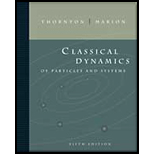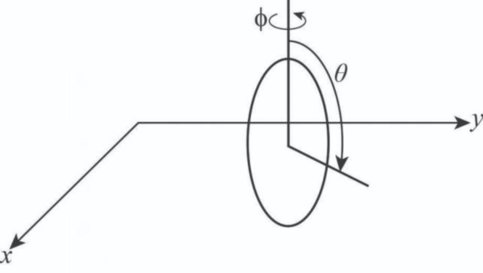
The generalized coordinates and description about the rolling disk.
Answer to Problem 7.1P
The generalized coordinates and description about the rolling disk are given.
Explanation of Solution
In order to describe the rolling of disk without slipping, four generalized coordinates are required. They are – x coordinate, y coordinate, angle

Equation of motion for the rolling disk is,
Here,
These equations are not integrable. Moreover, all the generalized coordinates cannot be combined into a single equation. Hence, the constraints are nonholonomic.
Conclusion:
Therefore, generalized coordinates and description about the rolling disk are given.
Want to see more full solutions like this?
Chapter 7 Solutions
EBK CLASSICAL DYNAMICS OF PARTICLES AND
- When current is flowing through the coil, the direction of the torque can be thought of in two ways. Either as the result of the forces on current carrying wires, or as a magnetic dipole moment trying to line up with an external field (e.g. like a compass). Note: the magnetic moment of a coil points in the direction of the coil's magnetic field at the center of the coil. d) Forces: We can consider the left-most piece of the loop (labeled ○) as a short segment of straight wire carrying current directly out of the page at us. Similarly, we can consider the right-most piece of the loop (labeled ) as a short segment straight wire carrying current directly into the page, away from us. Add to the picture below the two forces due to the external magnetic field acting on these two segments. Then describe how these two forces give a torque and determine if the torque acts to rotate the loop clockwise or counterclockwise according to this picture? Barrow_forwardIn each of the following, solve the problem stated. Express your answers in three significant figures. No unit is considered incorrect. 1. For the circuit shown, determine all the currents in each branch using Kirchhoff's Laws. (3 points) 6 5V 2 B C 4 A www 6 VT ww T10 V F E 2. Compute for the total power dissipation of the circuit in previous item. (1 point) 3. Use Maxwell's Mesh to find Ix and VAB for the circuit shown. (3 points) Ix 50 V 20 ww 21x B 4. Calculate all the currents in each branch using Maxwell's Mesh for the circuit shown. (3 points) www 5ი 10 24V 2A 2002 36Varrow_forwardIf the mass of substance (1 kg), initial temperature (125˚C), the final temperature (175˚C) and the total volume of a closed container (1 m3) remains constant in two experiments, but one experiment is done with water ( ) and the other is done with nitrogen ( ). What is the difference in the change in pressure between water and nitrogen?arrow_forward
- Using the simplified energy balance in Equation 1, suppose there is heat transfer of 40.00 J to a system, while the system does 10.00 J of work. Later, there is heat transfer of 25.00 J out of the system while 4.00 J of work is done on the system. What is the net change in internal energy of the system?arrow_forwardYou pour a litre (1 kg) of 25.0˚C water into a 0.500 kg aluminium pan off the stove, but has previously been heated so it starts with a temperature of 120˚C. What is the temperature when the water and the pan reach thermal equilibrium (i.e., what is the temperature of both objects when they reach the same temperature)? Assume that the pan is placed on an insulated pad and a negligible amount of water boils off.arrow_forwardA golf club hits a golf ball and the golf ball’s flight reaches a maximum height of 5.48 m. Calculate the momentum of the golf ball at the maximum height if the mass of the golf ball is 0.459 kg.arrow_forward
- • Superposition Theorem • Thevenin's and Norton's Theorem 1. Find the unknown voltage V₁, unknown resistances R1 and R2, and currents flowing through R1 and R2 for the circuit shown below using Superposition Theorem. 40 V + R₁₂ w B C ♥16A 10A www 4A F ww 2 E Ꭰ 2. Use Thevenin's Theorem to find the current flowing in 3-ohm resistor and its power dissipation from the circuit shown in the right. + 3. Use Norton's Theorem for the same instruction as for No. 2. 8 V A www 202 B wwww 20 Ω 10 V + 302 202 www C - 12 V 502 www.arrow_forwardFill in blanksarrow_forwardA rock is dropped from a height of 2.00 m. Determine the velocity of the rock just before it hits the ground. If the momentum of the rock just before hitting the ground is 14.0 kg m/s, what is the mass of the rock? Is the collision between the rock and the ground elastic or inelastic? Explain.arrow_forward
- Describe how the momentum of a single ball changes as it free falls from a height of approximately 1 m, collides with a hard floor, and rebounds.arrow_forward• Nature of Resistance Temperature-Resistance Relationship Ohm's Law, Energy and Power Kirchhoff's Law • • Maxwell's Mesh Analysis 1. The steel of the third rail of a railway system has a resistivity of 21.4 μ-cm. If its cross-sectional area is 8.2 in², calculate the resistance per mile of rail, neglecting the effect of joints between sections. (1 point) 2. An incandescent lamp has a tungsten filament whose resistance is 96 at its operating temperature of 2900°C. Calculate the filament resistance when the lamp is disconnected from the electric source, under which condition its temperature is 24°C. (Use do = 0.0045 02/°C for tungsten) (1 point) 3. For the circuit shown, find the following: 50 V 602 10 V 702 a. the value of resistor R. (1 point) b. the equivalent resistance with respect to the 50-V source. (1 point) 4. For the circuit shown, determine all the currents in each branch using Kirchhoff's Laws. (3 points) A 5V 2 В -ний C 4 6 VT ww F E 5. Use Maxwell's Mesh to find I, and VAB…arrow_forwardFor items 8-9, refer to the problem below. Find all the currents flowing in every resistor, power dissipation in every resistor and the total power of the circuit shown at the right using... 8. Kirchhoff's Laws (5 pts) 9. Maxwell's Mesh Analysis (5 pts) A 8 V 10 V B + 20 Ω 3Ω 202 wwww C wwww 202 + 50 www 12 Varrow_forward
 Classical Dynamics of Particles and SystemsPhysicsISBN:9780534408961Author:Stephen T. Thornton, Jerry B. MarionPublisher:Cengage Learning
Classical Dynamics of Particles and SystemsPhysicsISBN:9780534408961Author:Stephen T. Thornton, Jerry B. MarionPublisher:Cengage Learning Physics for Scientists and Engineers: Foundations...PhysicsISBN:9781133939146Author:Katz, Debora M.Publisher:Cengage Learning
Physics for Scientists and Engineers: Foundations...PhysicsISBN:9781133939146Author:Katz, Debora M.Publisher:Cengage Learning Principles of Physics: A Calculus-Based TextPhysicsISBN:9781133104261Author:Raymond A. Serway, John W. JewettPublisher:Cengage Learning
Principles of Physics: A Calculus-Based TextPhysicsISBN:9781133104261Author:Raymond A. Serway, John W. JewettPublisher:Cengage Learning University Physics Volume 1PhysicsISBN:9781938168277Author:William Moebs, Samuel J. Ling, Jeff SannyPublisher:OpenStax - Rice University
University Physics Volume 1PhysicsISBN:9781938168277Author:William Moebs, Samuel J. Ling, Jeff SannyPublisher:OpenStax - Rice University University Physics Volume 3PhysicsISBN:9781938168185Author:William Moebs, Jeff SannyPublisher:OpenStax
University Physics Volume 3PhysicsISBN:9781938168185Author:William Moebs, Jeff SannyPublisher:OpenStax Modern PhysicsPhysicsISBN:9781111794378Author:Raymond A. Serway, Clement J. Moses, Curt A. MoyerPublisher:Cengage Learning
Modern PhysicsPhysicsISBN:9781111794378Author:Raymond A. Serway, Clement J. Moses, Curt A. MoyerPublisher:Cengage Learning





